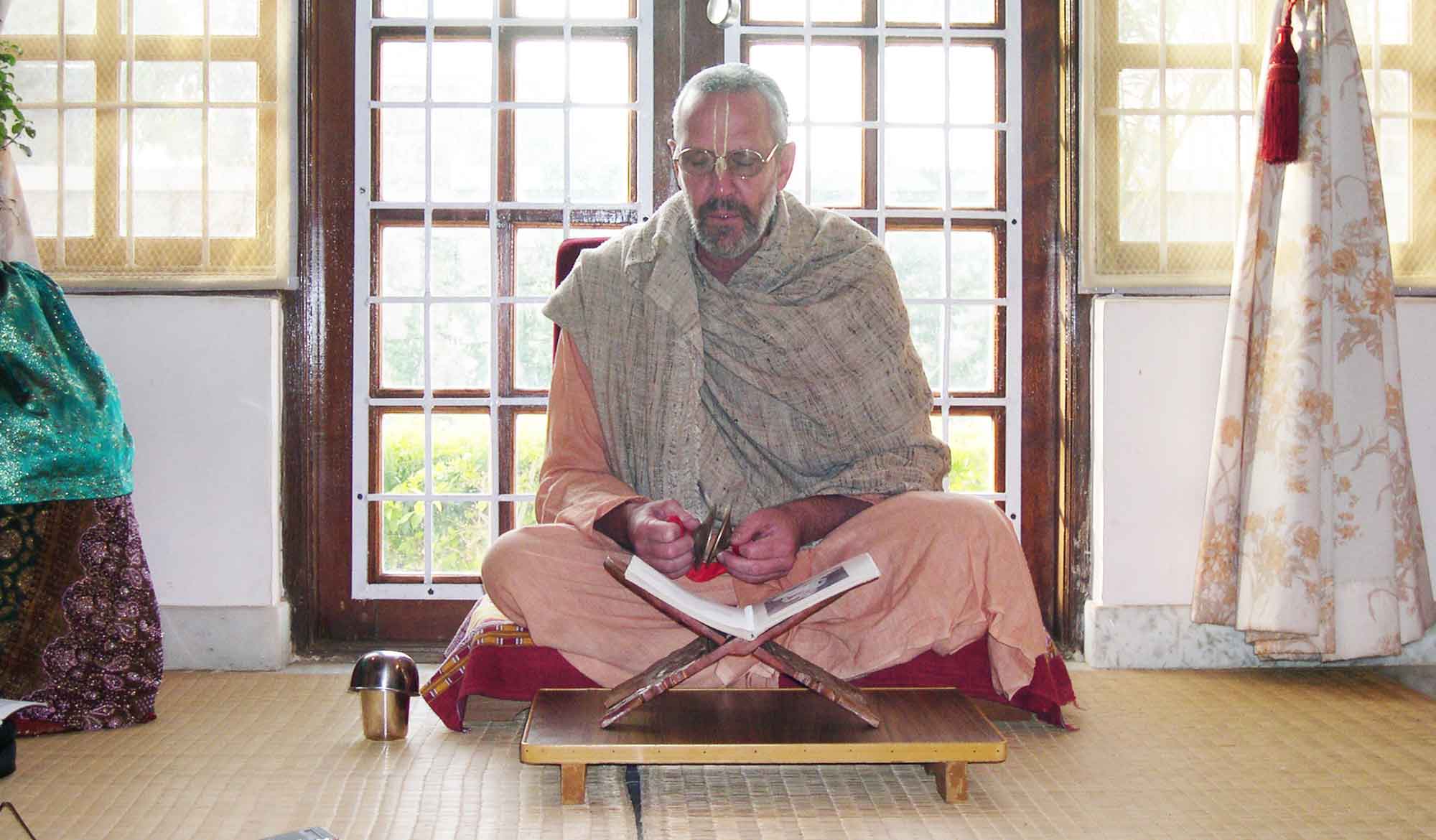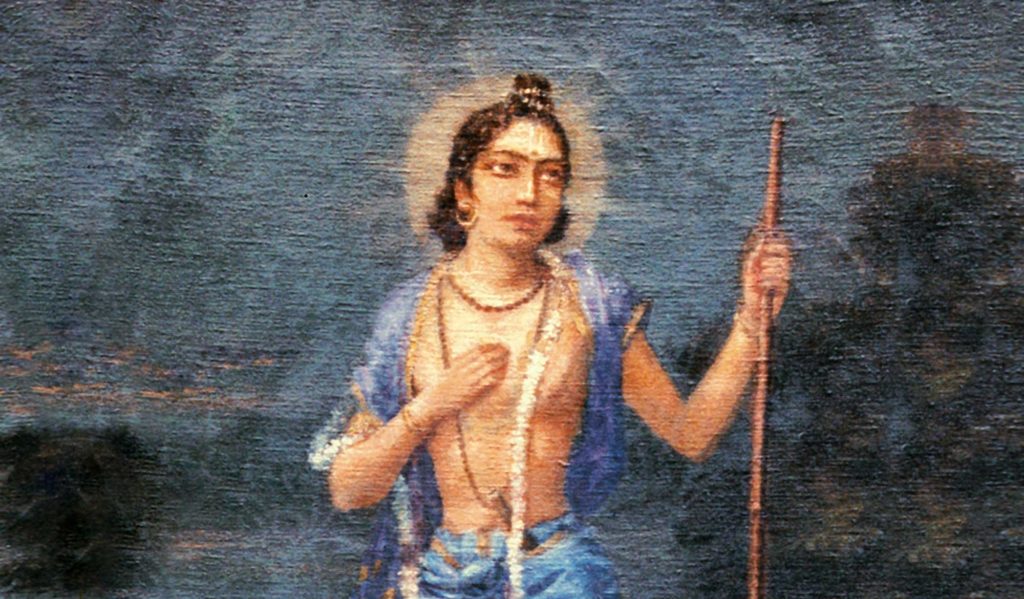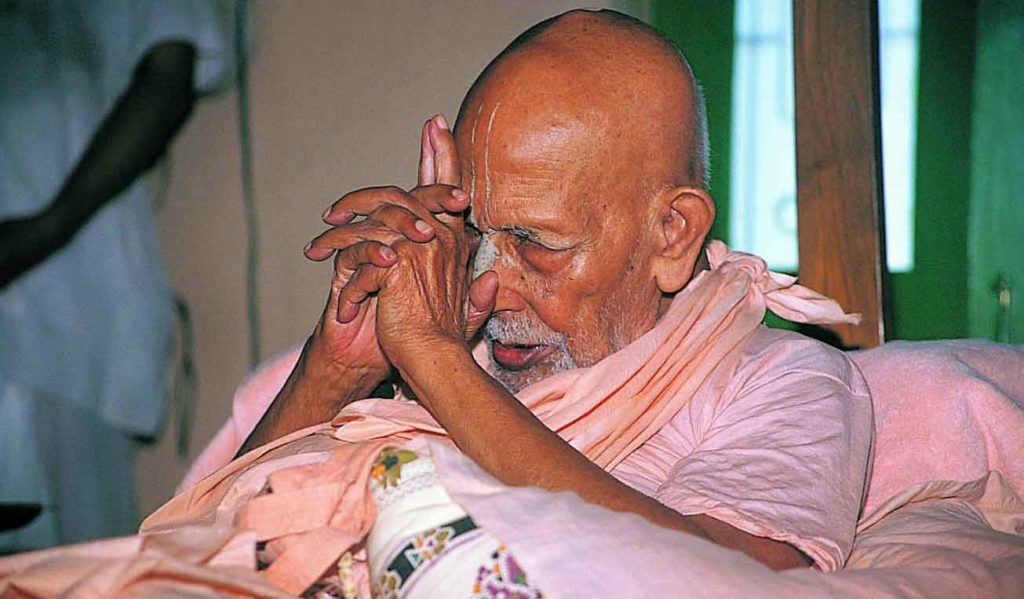Overview
In “Ativāḍī Apa-Sampradāya’ written in 2002, Śrīla Narasiṅgha Mahārāja gives a history of the Ativāḍī cult in both Purī and Vṛndāvana, and the pitfalls of knowledge without humility.
Devotee: Śrīla Bhaktivinoda Ṭhākura has written that there were thirteen apa-sampradāyas that developed after the time of Śrī Caitanya Mahāprabhu.
āula, bāula, kartābhajā, neḍā daraveśa, sāṅi
sahajiyā, sakhībekhī, smārta, jāta-gosāñī
ativāḍī, cūḍadhārī, gaurāṅga-nāgarī
totā kahe, ei tāra saṅga nāhi kari
One of these apa-sampradāyas is called Ativāḍī, which means too great. Can you please explain how those who are ‘too great’ have become an apa-sampradāya?
Narasiṅgha Mahārāja: If the quality of humility is the crest-jewel of the Vaiṣṇavas, and indeed it is, then undeniably its antithesis is pride. If one is falsely proud due to his greatness, or falsely proud due to his scholarship then one becomes an Ativāḍī, too great.
To chant the Holy Name without offense, one must first become free from dāmbha, or pride. A dāmbhika-brāhmaṇa is one who is proud of his scholarship and thus becomes offensive to the humble Vaiṣṇavas. A true Vaiṣṇava is always meek and humble. He sees every living entity as constitutionally a servant of Kṛṣṇa and he never mistreats others, or looks upon them as his inferior.
In the words of Śrīla Bhaktisiddhānta Sarasvatī Ṭhākura, “One who thinks he is the highest is actually the lowest and one who thinks himself the lowest is actually the highest.”
Real humility can only be attained by strictly adhering to the instructions of Śrī Guru and by preaching the glories of the Holy Name. However, a hypocrite in the guise of a Vaiṣṇava (kapaṭa-vaiṣṇava) sometimes makes a show of his learning simply to attain cheap adoration and followers. Such persons are known as Ativāḍī, too great.
The first pseudo sect of Vaiṣṇavas to be known as Ativāḍī was founded by one Oriyan brāhmaṇa named Jagannātha Dāsa. This Jagannātha Dāsa lived during the time of Śrī Caitanya. Jagannātha Dāsa came from a tradition of professional Bhāgavatam reciters and due to his sweet voice he attracted many followers. Jagannātha Dāsa claimed to be a disciple of Śrīla Haridāsa Ṭhākura, but he later broke his connection with Haridāsa and began to preach his own concocted philosophy.
Initially Jagannātha Dāsa resided in an āśrama donated to him by Mahārāja Pratāparudra, but after his rejection of Ṭhākura Haridāsa the king took the property back and Jagannātha Dāsa and his followers founded their own maṭha called the Ṣaṭ-lahiri Mandira. This story has been narrated in a Gauḍīya Maṭha publication compiled by one of Śrīla Bhaktisiddhānta’s disciples.
Jagannātha Dāsa once approached Mahāprabhu without getting permission from the Lord’s personal servant. Jagannātha Dāsa had written his own translation of the Bhāgavatam and desired to recite it for the Lord. This translation was in Oriyan and happened to contain five new chapters of the author’s own invention. In order to avoid hearing this concocted creation of Jagannātha Dāsa, the Lord told him, “A fallen jīva such as Myself is not worthy to hear the Bhāgavatam composed by a poet like you. You have become too great, ativāḍī. An insignificant soul like Me can have nothing to do with you.”
Being covered by false pride Jagannātha Dāsa and his many followers took Mahāprabhu’s sarcastic statement to be one of praise rather than condemnation. The followers of Jagannātha Dāsa then propagated his Bhāgavatam throughout Orissa. The true followers of Śrī Caitanya, however, reject the Bhāgavatam by Jagannātha Dāsa.
If one examines the cult of Jagannātha Dāsa, it becomes quite clear why Mahāprabhu shunned his association. Jagannātha Dāsa and his followers among other things claimed that Jagannātha Dāsa was the incarnation of Śrīmatī Rādhārāṇī, that he was the personification of Śrīmatī Rādhārāṇī’s laughter. Certainly such a claim could hold no bearing over the followers of Śrī Caitanya.
Another reason why Śrī Caitanya rejected Jagannātha Dāsa was because Jagannātha Dāsa contradicted the original text of Vyāsadeva and he sometimes leaned towards māyāvādī impersonalism.
Later, after being rejected by Śrī Caitanya, Jagannātha Dāsa began mixing freely with women. His melodious singing attracted many unsuspecting women folk to hear his Bhāgavatam recitations and serve him in various ways such as massaging his body. Eventually this came to the attention of Mahārāja Pratāparudra and Jagannātha Dāsa was arrested and interrogated by the King. When the King asked him about his behavior Jagannātha Dāsa replied, “I see no difference between men and women.” Mahārāja Pratāparudra then had Jagannātha Dāsa imprisoned for some time.
The Ativāḍī sect also claims that Lord Jagannātha reveals to them secret revelations of apocalyptic visions of the end of the world. It is indeed amusing that in recent times these Ativāḍī prophecies have even duped some western Vaiṣṇavas to travel to Orissa to have a glimpse of the future from an Ativāḍī priest known as the Copper-plate Bābā. This Copper-plate Bābā has been consulted numerous times by some western gurus and sannyāsīs in ISKCON. Little do they know that the Copper-plate Bābā is the representative of Jagannātha Dāsa and the Ativāḍī sect.
Unfortunately, in olden times the Ativāḍī mentality also entered other Gauḍīya Vaiṣṇavas and caused their fall down from pure devotional service. During the seventeenth century a man from the Surma valley in Assam entered the Vaiṣṇava communities of Bengal and Vṛndāvana. Eventually he took dīkṣā from Śrī Kṛṣṇa-caraṇa Cakravartī and became known as Rūpa Kavirāja. This Rūpa Kavirāja studied Śrīmad Bhāgavatam under Śrī Mukunda Dāsa, a well-known Vaiṣṇava of the time. The residents of Rādhā-kuṇḍa felt great happiness to see Rūpa Kavirāja engaged thus. Gradually though he became proud of his learning.
Soon after the disappearance of Śrī Mukunda Dāsa, Rūpa Kavirāja made a grave offence to the great Vaiṣṇavī Śrīmatī Kṛṣṇa-priyā Ṭhākurāṇī. One day, all the Vaiṣṇavas assembled to hear Rūpa Kavirāja recite the Bhāgavatam. Before he began, Kṛṣṇa-priyā Ṭhākurāṇī arrived and the devotees offered her all respects. Rūpa Kavirāja however, did not show her any respect. During his recital, Rūpa Kavirāja noticed that she was chanting and he became disturber at this. With anger, he asked Kṛṣṇa-priyā Ṭhākurāṇī, “How is it possible to be doing two things simultaneously? It is very disturbing to see how you are chanting while I am reciting the Bhāgavatam.”
With great humility, the Ṭhākurāṇī replied, “It is simply the habit of my tongue to chant continuously – it doesn’t impede my hearing at all.” Hearing this, Rūpa Kavirāja sat back and fumed in anger. From this moment he was ruined. He offended Kṛṣṇa-priyā Ṭhākurāṇī, then later he made offences to his guru, his parama-guru and other Vaiṣṇavas. Then Rūpa Kavirāja became more and more proud of his learning and was ultimately robbed of the results of his spiritual advancement.
Since that time the Gauḍīya Vaiṣṇavas have referred to Rūpa Kavirāja as being an Ativāḍī, one who is too great or knows too much.
Later on Rūpa Kavirāja published a manuscript supporting the sahajiyā conceptions and claimed that it had been written by Śrīla Rūpa Gosvāmī. For all of his outrageous activities, the daughter of Śrī Śrīnivāsa Ācārya, Śrīmatī Hemalatā Gosvāmīnī tore the kaṇṭhi-mālā from his neck and ostracized him from the Vaiṣṇava community. After this, the followers of Rūpa Kavirāja began to wear only one strand of tulasī beads since he was only left with one strand after they were broken by Hemalatā.
According to the false doctrine of Rūpa Kavirāja, known as Sauromya, one should imitate the gopīs of Vraja in ones sādhaka-deha in order to gain entrance into the confidential līlās of the Divine Couple. Rūpa Kavirāja was also against the worship of tulasī and śālāgrāma and the following of Ekādaśī vrata since the damsels of Vṛndāvana do not follow these vidhis.
In time the lustre of Rūpa Kavirāja disappeared and he soon contacted leprosy which spread rapidly throughout his entire body. Reduced to a decaying wretch, Rūpa Kavirāja fled to Bengal and tried to gain entrance into his guru’s āśrama pretending that everything was normal. But the Vaiṣṇavas of Bengal had already heard of his offenses and he was forced to leave Bengal. He then travelled to Orissa and stayed in the village of Khuriya-grāma. There his body became thoroughly eaten up with leprosy and in great pain he slowly died. It is said that he became a ghost who would haunt those who committed Vaiṣṇava aparādha.
The following paragraph is from an article by Śrīla Prabhupāda Bhaktisiddhānta Sarasvatī Ṭhākura on the life of Śrīla Viśvanātha Cakravartī which appeared in The Harmonist (Vol.18, No.18. 1922):
“Śrīnivāsa Ācārya’s famous daughter, Śrīmatī Hemalatā Ṭhākurāṇī, rejected an envious disciple named Śrī Rūpa Kavirāja from the Vaiṣṇava society. This Rūpa Kavirāja is counted amongst the deviant sub-branch of the Gauḍīya Vaiṣṇava sampradāya known as Ativāḍī — he spread his own concocted philosophy (against Gauḍīya tradition), stating that only a person in the renounced order of life is capable of acting as ācārya. He claimed that it was not possible for a householder to become a spiritual master. Fully disregarding the vidhi-mārga, or path of devotional rules and regulations, he also tried to preach a philosophical path of rāga-mārga, or spontaneous devotion, which was completely unregulated and undisciplined. He also claimed that smaraṇa (remembrance) was possible without the help of śravaṇa and kīrtana (hearing and chanting). Thus, Rūpa Kavirāja propagated a path that was contrary to the path shown by the Gosvāmīs. Therefore, Śrīla Cakravartī Ṭhākura has refuted these false conclusions in his āarārtha-darśini commentary on the third Canto of Śrīmad Bhāgavatam. Actually, this refutation is a rendering of the truths outlined in Śrīla Jīva Gosvāmī’s Bhakti Sandarbha.”
One may be very learned in the scriptures, one may be adept at quoting many ślokas, one may have some understanding of the Vaiṣṇava siddhānta and be proficient in explaining its subtle details, but if one is devoid of the quality of true humility then all these attributes are simply like decorations on a dead body. Śrīla Rūpa Gosvāmī has explained in Bhakti-rasāmṛta-sindhu that a devotee should not read too many books (bahu-śāstra-vyākhya-vivādi tyāgaḥ, or renouncing the study of many scriptures in order to make novel explanations and arguments). This point is also mentioned by Śrī Caitanya Mahāprabhu Himself in the Caitanya-caritāmṛta (Madhya–līlā 22.118) –
bahu-grantha-kalābhyāsa-vyākhyāna varjiba
“One should not partially study many scriptures just to be able to give references and expand explanations.”
Nowadays there are some pretentious devotees that deem themselves as very learned, traveling here and there, they speak on so-called high topics and compete for the cheap admiration of people who are ignorant in these matters. These so-called devotees expertly speak novel interpretations to the scriptures and sweet illustrative stories, but such discussions simply fall on the deaf ears of the unqualified audiences having only the impact of āraṇya–rodana-nyāya, crying out in the wilderness.
Learning alone does not qualify one as an advanced Vaiṣṇava, especially if by one’s learning one becomes proud and offensive to other Vaiṣṇavas. Study, or svādhyāya, is meant only to cultivate devotion to the Supreme Lord. Too much learning, even of a good thing, may sometimes cause one to become puffed up and proud. Great learning must therefore be balanced by great Vaiṣṇava humility, otherwise one becomes an Ativāḍī, too great.
Related Articles
- A Rūpānuga’s Constant Meditation Concerning Śrī Ratha Yātrā by Śrīla B.R. Śrīdhara Mahārāja
- Śrī Nimbāditya and Nimbārka Are Not the Same Person by Śrīla Bhakti Prajñāna Keśava Mahārāja
- Ratha Yātrā in Navadvīpa by Śrīla Bhakti Gaurava Narasiṅgha Mahārāja
- A Brief Response to Ratha Yatra in Navadvīpa by Śrīla Bhakti Gaurava Narasiṅgha Mahārāja
- Bhaktivedānta by Śrīla Bhakti Gaurava Narasiṅgha Mahārāja
- Śrīdhara Deva Gosvāmī by Śrīla Bhakti Gaurava Narasiṅgha Mahārāja
- Ativāḍī Apa-Sampradāya by Śrīla Bhakti Gaurava Narasiṅgha Mahārāja
- Hita Harivaṁśa and the Rādhā-Vallabha Sect by Swami B.V. Giri
- The Temple of Understanding by Śrīla Bhakti Gaurava Narasiṅgha Mahārāja
- Māyāpura and the Adbhūta Mandira by Śrīla Bhakti Gaurava Narasiṅgha Mahārāja
- The Adbhūta Mandira and Bhaktivinoda’s Vision by Śrīla Bhakti Gaurava Narasiṅgha Mahārāja
- Nimbārka and Keśava Kāśmīrī by Śrīla Bhakti Gaurava Narasiṅgha Mahārāja
- The Mystery of the History of the Līlā of Dāmodara by Śrīla Bhakti Gaurava Narasiṅgha Mahārāja
- Prabodhānanda and Prakāśānanda by Swami B.V. Giri
Further Reading
- A Discussion in Relation to the Dates of the Six Gosvāmīs by Śrīla Bhaktivinoda Ṭhākura
- Śrī Śrī Rūpa Gosvāmī Prabhu by Śrīla Bhaktivinoda Ṭhākura
- Śrī Śrī Sanātana Gosvāmī Prabhu by Śrīla Bhaktivinoda Ṭhākura
- Śrī Śrī Gopāla Bhaṭṭa Gosvāmī Prabhu by Śrīla Bhaktivinoda Ṭhākura
- Śrī Śrī Jīva Gosvāmī Prabhu by Śrīla Bhaktivinoda Ṭhākura
- Śrī Śrīnivāsa Ācārya Prabhu by Śrīla Bhaktivinoda Ṭhākura
- Śrī Śrī Kṛṣṇa Dāsa Kavirāja Gosvāmī Prabhu by Śrīla Bhaktivinoda Ṭhākura
- Śrī Śrī Prabhu Rāmacandra Gosvāmī by Śrīla Bhaktivinoda Ṭhākura
- Kavi Rāma Prasāda (The Poet Rāma Prasāda) by Śrīla Bhaktivinoda Ṭhākura
- Śrī Śrī Abhirāma Gosvāmī by Śrīla Bhaktivinoda Ṭhākura
- Śrī Parameśvarī Dāsa by Śrīla Bhaktivinoda Ṭhākura
- Śrī Jāhnavā Devī by Śrīla Bhaktivinoda Ṭhākura
- Salve for the Eyes of the Blind by Śrīla Bhaktivinoda Ṭhākura
- Śrī Bhāgavatācārya by Śrīla Bhaktivinoda Ṭhākura
- The Place of Śrīla Bhāgavatācārya by Śrīla Bhaktivinoda Ṭhākura
- The Inauguration of a Prapannāśrama in Amaljoda by Śrīla Bhaktivinoda Ṭhākura
- A Question and Answer Concerning Śrī Kṛṣṇa Saṁhitā (Praśnottara) by Śrīla Bhaktivinoda Ṭhākura
- An Earnest Appeal by Śrīla Bhaktivinoda Ṭhākura
- Śrī Śrī Hari Dāsa Ṭhākura’s Place in Kulīnagrāma by Śrīla Bhaktivinoda Ṭhākura
- The Place of Śrī Nakula Brahmacārī by Śrīla Bhaktivinoda Ṭhākura
- Śrīpāṭa Denuḍa by Śrīla Bhaktivinoda Ṭhākura
- Śrīdhāma Māyāpura by Śrīla Bhaktivinoda Ṭhākura
- Śrī Śyāmānanda Gosvāmī by Śrīla Bhaktivinoda Ṭhākura
- Śrī Māna Sarovara by Śrīla Bhaktivinoda Ṭhākura
- Gata-varṣa (The Last Year) by Śrīla Bhaktivinoda Ṭhākura
- The Temple of Śrī Śrī Jagannāthadeva by Śrīla Bhaktivinoda Ṭhākura
- Nāḍā by Śrīla Bhaktivinoda Ṭhākura
- The Instructions of Śrīmad Rāmānuja Svāmī – the Ācārya of the Śrī Sampradāya by Śrīla Bhaktivinoda Ṭhākura
- Śrīman Nimbāditya by Śrīla Bhaktivinoda Ṭhākura
- Śrī Acyutānanda’s Departure by Śrīla Bhaktivinoda Ṭhākura
- British Rule and the Vaiṣṇavas by Śrīla Bhaktivinoda Ṭhākura
- The Society of Śrī Gaurāṅga by Śrīla Bhaktivinoda Ṭhākura
- The Temple of Jagannath at Puri by Śrīla Bhaktivinoda Ṭhākura
- A Review of the Previous Year by Śrīla Bhaktivinoda Ṭhākura
- Prabodhānanda and Prakāśānanda by Śrīla Bhaktivinoda Ṭhākura
- Rādhā-kuṇḍa and Śyāma-kuṇḍa by Śrīla Bhaktivinoda Ṭhākura
- Puratana Gañja of Śrīdhāma Navadvīpa by Śrīla Bhaktivinoda Ṭhākura
- What Has Happened in Śrī Māyāpura? by Śrīla Bhaktivinoda Ṭhākura
Pilgrimage with Swami Narasiṅgha – Part 7: Keśī Ghāṭa
Continuing with our pilgrimage series, this week Śrīla Narasiṅgha Mahārāja takes us to Keśī Ghāṭā where he tells us about Madhumaṅgala’s meeting with the Keśī demon, what Keśī represents, and how Śrīla Prabhupāda almost acquired Keśī Ghāṭa. Mahārāja also narrates his own experience. This article has been adapted from a number of talks and articles by Narasiṅgha Mahārāja.
Prema Dhāma Deva Stotram with the Narasiṅgha Sevaka Commentary – Verses 61-65
In verses 61 to 65 of 'Prema Dhāma Deva Stotram', Śrīla Śrīdhara Mahārāja narrates the pastime of Śrī Caitanya at Caṭaka Parvata In Purī and explains how the scriptures produced by Brahmā and Śiva are ultimately searching for the personality of Mahāprabhu who is merciful too all jīvas, no matter what their social position.
Prabhupāda Śrīla Sarasvatī Ṭhākura’s Visit to Ayodhyā
With the forthcoming observance of Śrī Rāma Navamī, we present 'Prabhupāda Śrīla Sarasvatī Ṭhākura’s Visit to Ayodhyā' written by Śrīla Bhaktisiddhānta Sarasvatī Ṭhākura Prabhupāda from The Gaudīyā magazine, Vol 3. Issue 21/ In December 1924, after visiting Benares and Prāyāga, Sarasvatī Ṭhākura visited the birth-site of Śrī Rāmācandra in Ayodhyā.
Śaraṇāgati – The Only Path to Auspiciousness
In this article, 'Śaraṇāgati - The Only Path to Auspiciousness', Dhīra Lalitā Dāsī analyses the process of śaraṇāgati (surrender) beginning with śraddhā (faith). She also discusses the role of śāstra and the Vaiṣṇava in connection with surrender.
Pilgrimage with Swami Narasiṅgha – Part 7: Keśī Ghāṭa
Continuing with our pilgrimage series, this week Śrīla Narasiṅgha Mahārāja takes us to Keśī Ghāṭā where he tells us about Madhumaṅgala’s meeting with the Keśī demon, what Keśī represents, and how Śrīla Prabhupāda almost acquired Keśī Ghāṭa. Mahārāja also narrates his own experience. This article has been adapted from a number of talks and articles by Narasiṅgha Mahārāja.
Prema Dhāma Deva Stotram with the Narasiṅgha Sevaka Commentary – Verses 61-65
In verses 61 to 65 of 'Prema Dhāma Deva Stotram', Śrīla Śrīdhara Mahārāja narrates the pastime of Śrī Caitanya at Caṭaka Parvata In Purī and explains how the scriptures produced by Brahmā and Śiva are ultimately searching for the personality of Mahāprabhu who is merciful too all jīvas, no matter what their social position.
Prabhupāda Śrīla Sarasvatī Ṭhākura’s Visit to Ayodhyā
With the forthcoming observance of Śrī Rāma Navamī, we present 'Prabhupāda Śrīla Sarasvatī Ṭhākura’s Visit to Ayodhyā' written by Śrīla Bhaktisiddhānta Sarasvatī Ṭhākura Prabhupāda from The Gaudīyā magazine, Vol 3. Issue 21/ In December 1924, after visiting Benares and Prāyāga, Sarasvatī Ṭhākura visited the birth-site of Śrī Rāmācandra in Ayodhyā.
Śaraṇāgati – The Only Path to Auspiciousness
In this article, 'Śaraṇāgati - The Only Path to Auspiciousness', Dhīra Lalitā Dāsī analyses the process of śaraṇāgati (surrender) beginning with śraddhā (faith). She also discusses the role of śāstra and the Vaiṣṇava in connection with surrender.








